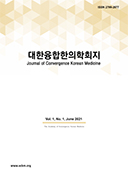 ISSN : 2799-2977
ISSN : 2799-2977
Vol.4 No.1
Abstract
Objectives: Inflammasomes are molecular platforms that are generated inside cytoplasmic compartments. The objective is to mediate immunological responses of the host to cell damage and infection. Caspase-1 is triggered by inflammasome to generate interleukin-1𝛽 (IL-1𝛽), an inflammatory cytokine, and pyroptosis, an inflammatory form of apoptosis. Methods: In the past two decades, scientists have uncovered several inflammasomes. The most research has been conducted on NLRP3 inflamamsomes, whose activity can be stimulated by a variety of induction factors. However, the unregulated activation of NLRP3 inflammasomes is also a role in the etiology of several human disorders. Previous research has demonstrated that NLRP3 inflammasomes have a significant role in the innate and acquired immune systems, as well as in the prevalence of joint illnesses such rheumatoid arthritis. Conclusion: Within the scope of this review, we will present a brief overview of the biological features of NLRP3 inflamamsomes as well as a description of the underlying mechanisms governing activation and regulation. In particular, we explore the function of inflammasomes in the development of rheumatoid arthritis as well as the promise of recently identified medicines that target inflamasomes.
Abstract
Objectives: Primary dysmenorrhea is a representative disease that causes intestinal pain, and it has long been known that acupuncture treatment is effective. In this study, a network analysis was conducted using acupuncture points reported in the existing systematic literature review, and the combination of acupuncture points used to treat primary dysmenorrhea was analyzed. Methods: Among of a total of 60 papers, excluding those that used ear acupuncture, the analysis results indicated that combinations of BL23, BL40, BL25, BL60, BL30, Ashi-points, BL26, GB34, and GV3 were used in combination. Results: Through this, it can be seen that previous studies to reveal the effectiveness of acupuncture on back pain mainly used the acupoints of the bladder meridian (BL), local acupoints group, and distal acupoints group. Conclusion: In order to reveal the correlation between acupoints and therapeutic effects through future studies and to provide guidelines on the principles of selecting and combining acupoints, it is necessary to employ a quantitative analysis method for therapeutic effects and to provide detailed reports on acupoints.
Abstract
Objectives: TSepsis and subsequent acute lung injury (ALI) is a critical state of health caused by infection or endotoxins. This study was conducted to evaluate the effect of Water Extract of Aconiti Lateralis Preparata Radix (AR) on lipopolysaccharide (LPS)-induced sepsis in C57BL/6 mice. Methods: Male C57BL/6 mice were intraperitoneally injected with LPS to induce sepsis and ALI. AR was orally fed twice at 30 min and 180 min after LPS injection. At 24 h post injection, mice were sacrificed, bronchoalveolar lavage fluid (BALF) and blood was collected, and lung tissue was harvested. Hematoxylin and eosin staining was performed in lung tissues, wet/dry ratio of the lung tissue was measured, and the serum cytokine and chemokine levels were analyzed. Results: AR revoked the LPS-induced pathological changes in lung tissues, such as abnormal histological structures, immune cell infiltration and lung edema. Also, AR suppressed the neutrophil infiltration into the lung which was greatly increased by LPS injection based on the cell content of collected BALF. Serum cytokines and chemokines were measured, and AR reversed the LPS-induced increase of cytokines such as interleukin 1 beta, interleukin 6, tumor necrosis factor alpha and chemokines including C-X-C motif chemokine ligand 1 and 2. Conclusion: TAR showed a protective effect in the pathological progress of LPS-induced ALI. Especially, AR suppressed lung edema and infiltration of neutrophils by inhibiting cytokine and chemokine expressions. Such results demonstrate the potential of AR as a therapeutic agent for sepsis and sepsis-induced ALI.
Abstract
Objectives : The purpose of this study was to investigate the anti-inflammatory effects of the aqueous extract of the steamed radix of Rehmanniae glutinosa (SRG) on periodontitis in ligature-induced rat model. Methods: To induce the periodontitis, ligature was placed around the lower first molar in rats. Rats were divided into 4 groups (n = 7), NL (non-ligatured and vehicle-treated), L (ligatured and vehicle-treated), SRG1 (ligatured and 1 mg/kg SRG-treated) and SRG100 (ligatured and 100 mg/kg SRG-treated). Vehicle or SRG solution was applied daily for 14 days and then all experimental rats were sacrificed. To examine the effect of SRG solution on periodontitis, the level of alveolar bone loss, cementum regeneration, gingival tissue degradation, and osteoclast cell numbers were analyzed. Results: Alveolar bone loss was inhibited in ligature-induced periodontitis rats treated with SRG treatment. Histopathological cementum was recovered in SRG1 and SRG100 groups. SRG extract inhibited gingival tissue degradation induced by ligature. In addition, the numbers of osteoclast cells were decreased by treatment SRG in periodontitis rats. Conclusion: Taken together, these results suggest that SRG have inhibitory effects against periodontitis. Therefore, the steamed radix of Rehmanniae glutinosa has may be a potential alternative for periodontitis.
